We’re excited to share an interview with AJ Silberman-Moffitt, a talented writer and editor at Tandem.Buzz. AJ has an interesting career journey that took her from a passion for theater to eventually finding her calling in content marketing and copywriting.
In this interview, she opens up about her approach to creating compelling writing that connects with audiences and shares her strategies for optimizing content for search engines while maintaining quality. She also gives her thoughts on how AI and technology are shaping the future of content creation.
AJ has experience working as both a freelancer and a full-time employee, giving her valuable insights into the pros and cons of each path. Her advice for aspiring women writers is truly motivating and heartfelt.
AJ’s Creative Odyssey in Writing

PRNEWS.IO: Hi AJ! To get started, could you tell us a bit about yourself and your journey into the world of content marketing and copywriting?
When I was younger, I never thought of myself as a writer. Though I generally received high scores on anything I wrote, writing wasn’t something that I thought would become my career. Instead, a friend of mine got me interested in theater when I was a freshman. I always had a creative spirit, so it was not surprising that from that point until I graduated from high school, theater was my passion.
The theater was such a large part of my life that my first year of college was spent at the Florida School of the Arts, where I had a scholarship to study Costume Design. While there, I realized that, as much as I loved the theater, it would suit me better as a hobby than a career.
With this new-found information, I finished my Associate’s degree at my local community college. However, I stopped my educational journey when I married my first husband and divorced him two years later. After that, I did general office work for a few years until I realized that companies wanted to see that I had a piece of paper.
In 2000, I attended Florida Atlantic University’s School of Business. At the time, I wasn’t entirely certain about what I wanted to do after graduation, other than I knew I wanted to work in an office. I thought a degree in Marketing and Advertising would be a good way to get a business degree while also staying true to myself and the creativity that I love.
When I graduated in 2002, I had issues finding a marketing position. I worked for a restaurant and a lawyer before getting a job at an advertising agency in 2004. Though I worked in the traffic department, having commercials produced and sent to the stations, my skills were also utilized to proofread and edit. I should have realized then I was a writer, but, alas, I did not.
By 2011, personal situations had me questioning what I wanted to do for the rest of my life. My job in the traffic department was important, but I didn’t feel fulfilled. I left office work and went into the service industry for 7 years. It was during that time that I realized my passion was in writing and editing. I left the service industry and found a copywriting position with an online retailer. That was a great experience, as it confirmed what I thought. Deep down, I was a writer.
After that copywriting position, I transitioned to copywriting for a global company in the pharmaceutical field, but COVID-19 left me without a position. I did contract work but realized I prefer working for someone else instead of working for myself. Shortly after, I found a position at Tandem.Buzz. Now that I am here, in addition to being a writer, I am the Senior Editor and the Buzz Ambassador. If you don’t know what a Buzz Ambassador is, don’t worry. Most people don’t.
As the Buzz Ambassador, I represent Tandem.Buzz doing public relations (PR) at conferences and other events. I also submit responses with insights to HARO, Qwoted, SourceBottle, and others. Another responsibility of mine is online reputation management or ORM. This is similar to PR, but instead of focusing on spreading positive information, the goal is more aimed at removing what’s bad.
I love where my journey has taken me. Tandem.Buzz is a great company. Both the Founder and President, Joe Laratro, and the Chief Marketing Officer, Brittni Swenson, are incredibly knowledgeable and talented. I have learned so much during my time at the company. I know they will help me flourish, grow, and achieve my goals as long as I am here.
PRNEWS.IO: Compelling copywriting can make a huge difference. How do you approach crafting effective copy that resonates with target audiences?
Many people don’t realize that when I am editing, much of that process revolves around researching. The same goes for copywriting. Whether I am writing about something I am familiar with or know nothing about, the first step in crafting effective copy is research. Using snazzy words and pretty jargon might make the copy look pretty. Still, there is a difference between being pretty and being effective.
When discussing research, I mean more than providing facts related to a topic. This also includes answering questions related to the topic. Do I need to make the content more complex or simplify it? Am I crafting the right message in the appropriate voice? Is the copy length appropriate for the medium?
I also utilize artificial intelligence (AI) when crafting some copy. Don’t worry – I didn’t use it here. Programs like ChatGPT, Microsoft Copilot, and Google Gemini are great tools for researching and finding alternate ways of writing copy. But no matter how “smart” these AI programs get, what they write isn’t the same as human-written content. Finding a happy medium and writing smarter, not harder, is essential.

PRNEWS.IO: Search Engine Optimization (SEO) is vital for content visibility. How do you ensure your content is optimized for search engines without compromising its quality?
When I first began working in SEO at Tandem.Buzz, I didn’t have much experience in writing content that’s been optimized for search engines. One of the first things I noticed was that whether you are writing content for SEO or something to captivate your audience, they both generally follow the same principles.
In the past, for SEO purposes, it was integral to use the exact words or phrases that people were searching for (keywords) in the same order as the people using them in their searches. Fortunately, as technology has evolved and SEO tactics have improved, Google and other search engines have also improved. Now, when someone types the word “car,” these web crawlers understand that they could be searching for automobile, convertible, coupe, minivan, or an array of other synonyms that could be used to describe cars.
It used to be much harder to find the balance between something being grammatically correct and being optimized following the best SEO practices. The algorithms used today make it much easier to write content that can be more easily found online while also being high-quality.
PRNEWS.IO: What are some of the latest trends you see shaping the future of content creation?
When I think about the future of content creation, I sometimes feel like the future is now. We already have AI capable of writing content that can frequently fool people into thinking it was humanly written. Some people are concerned that artificial intelligence will fully replace humans in writing. I don’t foresee this happening. Yes, AI will continue to evolve, get more complex, and provide additional solutions for various problems. But artificial intelligence can’t fully grasp the human experience. How will AI feel the rain from a thunderstorm or understand the devastation a tornado leaves along its path?
The artificial intelligence programs we use to write content are large language models (LLMs), sometimes called predictive language models. When you ask an LLM to answer a question or otherwise provide information, the LLM takes the words from your request or prompt and “predicts” what that answer is. This means AI isn’t thinking for us. It’s predicting for us.
It might be fun to think the movie The Terminator was right and that Skynet will try to rule the world. But Skynet, or any similar program, is not something current generations must worry too much about. Why am I talking about a fictional movie from the past when I am supposed to be answering about the future? Because, in a way, the movie wasn’t entirely wrong.
AI and other improving technologies will continue to impact content. Artificial intelligence might appear to be getting smarter, but it’s not. It’s just better learning to predict more human-like responses. More importantly, the more things change, the more things will stay the same.
Works from the past like William Shakespeare’s “Much Ado About Nothing,” Mark Twain’s “The Adventures of Tom Sawyer,” Toni Morrison’s “Beloved” and Agatha Christie’s “Murder on the Orient Express” weren’t ideas they found through artificial intelligence. These were creations from inside their minds. Unless we can teach AI to read minds, we’ll continue to rely on the human connection that writing provides.
Of course, we’ll see vast technological improvements that can help shape the future of content creation. I already rely on AI daily when I use Grammarly to check my spelling and grammar or when I use Otter.ai to record and transcribe the audio of my meetings. But writing is not math.
One plus one equals two. No matter the path you take to get there, the answer to the question, “What is one plus one?” is always “Two.” What about the play “Cyrano de Bergerac” and the film “Roxanne”? They basically tell the same story. Yet, they are told in two distinctly unique ways. That’s because writing is compiling words together. It’s creating a piece using vibrant imagery, articulate alliteration, symbolism, metaphors, and other literary devices. I don’t foresee that changing too much. At least not anytime soon.
PRNEWS.IO: As a woman in a competitive field like content marketing, have you faced any specific challenges? If so, how have you navigated them?
I’ve faced many challenges and obstacles throughout my career. I don’t know if they are more related to being female or because I can often be hard-headed. Likely, it’s a combination of the two.
I know that I can be verbose. This is especially true when I am speaking. I can’t edit myself when I speak in the same way that I can when I write. People who know me as chatty are often presumptuous. They believe that because I frequently say excessive words, I also write with excess. Certainly, my responses to this interview illustrate me being long-winded. I want people to realize that I say what I mean and I mean what I say. That every word was written with a purpose. I try to create pictures with my words and to help people get a sense of my personality through my writing. My goal is to ensure that if it takes you five minutes to read an email from me instead of the three minutes it takes to read most other emails, the extra two minutes you spend reading is time well spent.
On top of this, perception can be reality. Some people make presumptions, with many of these being based on gender. I’m grateful that my name, AJ, is somewhat androgynous. Is AJ a female? Is she a male? Does it really matter?
The reality is that we all face challenges at different points in our lives, and the obstacles one person faces might be completely different from yours. The best thing I can do is tackle each challenge individually. I try not to be hypocritical and lump together any one situation with another.
We are all human, and we all make mistakes. We are perfectly imperfect. But as long as we try our best and learn from our mistakes, we can prepare for the next challenges.

PRNEWS.IO: What advice would you give to aspiring women who want to build a successful career in content marketing or copywriting?
Since I started doing office work many moons ago, I have had the privilege of working in many different industries. From working at a bail bonds office to a law office to an accounting office to a theater, and oh so many others, I now know a little about many things. And I am happy that I have had these experiences.
However, having worked in so many different professions over the past 30+ years isn’t necessarily the best path I could have taken to get where I am today. I believe my problem was that I listened to my head instead of my heart.
Here is the advice I can give to women who want to get into writing. Don’t let your head talk you out of doing something you are passionate about. If you let your heart be your guide, you’ll end up where you should be.
PRNEWS.IO: You have experience working as both a freelancer and in a full-time agency role. What are the pros and cons of each approach, and how did you decide which path to pursue with Tandem.Buzz?
I currently work full-time at Tandem.Buzz and I don’t plan to leave there anytime soon. I still occasionally do some freelance work. I don’t do it for extra money but because I love helping people. It’s the same reason I enjoy editing. I help pieces go from being really good to being great.
There are many pros and cons of working for yourself via freelance and working for a company. The pros of working for yourself start with having autonomy. But they also include your ability to set your own hours, dictate your rates, and work as hard (or not as hard) as you would like. However, there are also some cons of freelance work. Your paycheck can significantly vary from week to week. You must have the space to get your professional work done along with your personal obligations. Plus, it can be lonely at times.
Regarding the pros and cons of office work, the pros include a more steady paycheck, your day-to-day is typically more social, and there are generally more places where you can grow. On top of these, depending on the industry, working for a company often means more access to more resources. This comes in handy when you realize the numerous tools you use regularly aren’t free. There are also some cons. Your autonomy won’t be the same, nor will you have the same freedom in setting your hours. You might work with people you wouldn’t generally hang out with or you could even find yourself in uncomfortable situations.
Regardless of what others tell you, remember that just because one person loves freelancing and the other likes working for corporations doesn’t mean one is better. The two are simply different. You don’t need to merely figure out what’s right. You need to figure out what is right for you.
In 2021, when I started at Tandem.Buzz, I was facing some challenges in my personal life. I felt it would be easier to be assigned work instead of constantly looking for work. I’m so glad I made that decision. The Founder and President, Joe Laratro, and the Chief Marketing Officer, Brittni Swenson, are equally brilliant and exceptionally good at what they do. They consistently give Team Tandem the tools they need to learn and succeed. I have probably learned more in the past 3 years than in the 10 years preceding it.
PRNEWS.IO: How do you measure the success and return on investment (ROI) of content marketing campaigns for your clients?
Our content marketing campaigns go beyond writing and posting content. In addition, we implement SEO best practices to ensure that our clients are more easily found online when searchers look for a product or service the clients provide. As I work in the SEO department, we rely on key performance indicators (KPIs) and benchmarks that indicate how well our efforts work. This information is found using Google Search Console and Google Analytics 4 (GA4). These tools can tell us how many people went to a website, how they found it, and other relevant information. What’s great is that we can check the URL of a piece of content to specifically see how well it is performing.
In addition to the reporting, we meet with most of our clients once a month. It’s essential to see the story from your client’s perspective because they can access information that your KPIs and benchmarks won’t reflect. For example, if you have a customer with a brick and mortar, how much foot traffic have they recently received? How are their sales numbers looking? But by taking the big picture into account, you’ll have a more accurate measure of success and ROI for your client.

PRNEWS.IO: Looking ahead, what are your predictions for the future of content marketing?
I know I’ve said this already, but the more things change, the more things will stay the same. Many companies and individuals have already embraced AI as a tool for improving their content output. Now, these same people are realizing the importance of using AI as a tool, not a replacement. As we move into the future, they will spend more time personalizing content and ensuring it is unique.
In addition to users utilizing AI, search engines are also relying more heavily on AI. SGE is basically generative AI used to help web searches and is changing how online search works. Instead of figuring out how to phrase their searches so the browsers understand, with SGE, people can use searches that are written more conversationally. There are other benefits of SGE, including the ability for images to be created by the AI, enabling individuals to visualize what is being explained to them more easily.
Another event occurring “in the now” that I predict will continue is the integration of more channels through the customer journey. In the past you could use branding and search engine optimization tactics independently. As we learn more and improve our processes, we realize the increasing importance of branding in creating and maintaining search engine optimized websites. As an editor, I have known this for some time. I knew I could not merely look at content for SEO and grammatical purposes. I realized I also had to review:
- Voice: Is the voice being used the proper choice for the audience?
- Message: Is the message being shared easy to identify?
- Readability: Will the audience who reads it be able to understand it?
- User experience (U/X):- Does the piece have flow and make sense?
- Aesthetics: Is the piece visually appealing? Does it use bullets and bold or other tactics to make important sections stand out?
In the end, I see writing and content marketing flourishing more. It will better ensure companies and their existing and potential customers have a good ride through the customer journey funnel. Ultimately, I believe everyone will win.
PRNEWS.IO: Please, share your Instagram LinkedIn account:
I do not actively post on Facebook or Instagram, but I try to be active on my LinkedIn account. Even if I am not posting frequently, I am looking at my feed, contacts, and messages to ensure I have a feel of the pulse of the digital marketing, SEO, and PR communities.





